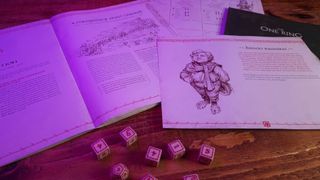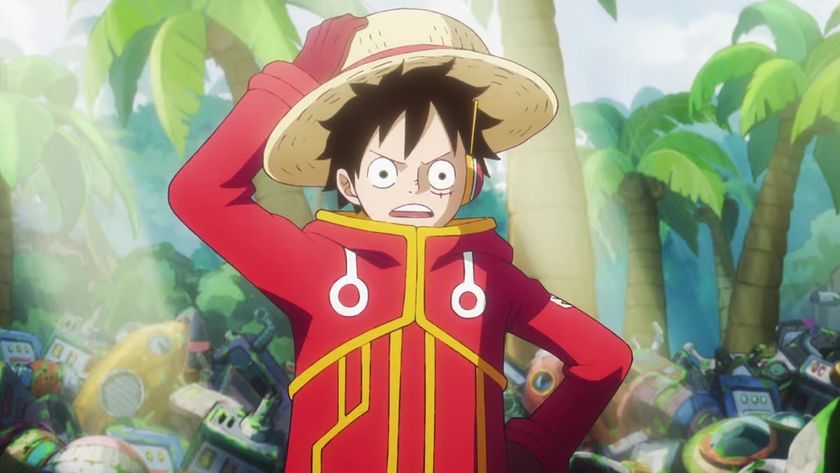The One Ring and Lord of the Rings Roleplaying are the RPGs Tolkien fans have always wanted
Opinion | These games capture Middle-earth better than any other

Toward the back of the original Dungeon Master’s Guide for Advanced Dungeons & Dragons, there was a list of inspirational reading. Some of the suggested authors, like Robert E. Howard, Jack Vance and Edgar Rice Burroughs, were very obvious influences on the game. Others, such as H. P. Lovecraft and Roger Zelazny, were less clear but could be seen in some niche concepts. In between, there was a name that was both: wholly, inescapably iconic if you enjoyed modern fantasy, yet whose work seemed curiously distant from one of the best tabletop RPGs. That author was J.R.R. Tolkien.
At first, this might seem like a peculiar claim: how can a game full of magic rings not have a strong relationship with the book that popularised the idea of magic rings? How can a system that features a copyright-skirting people known as “halflings” and rewards them for being “thieves” not have pilfered the concept outright from Bilbo Baggins, the hobbit burglar? Yet when you delve into the relationships, the problems become clear. Rings in Tolkien’s work were artefacts of unimaginable power, limited in number or closely held, not minor trinkets left forgotten in treasure chests for adventurers to find. Bilbo was brave and stealthy, but his heroics were a far cry from backstabbing monster hordes for experience points.
Missing the point

This, then, was the problem. In trying to make the game as exciting to play and as open-ended to imagine as possible, Dungeons and Dragons books forgot all the things that make Tolkien’s work special. In the books, combat was rare and a choice of last resort, whereas role-playing games developed from wargames. Character development was based on genuine growth and learning, not the empty accumulation of power. Most problematic of all was magic, a concept that Tolkien left intentionally rare and enigmatic in a setting he otherwise filled out in fastidious, obsessive detail was, in the game, given out freely to any character that wanted to be an apprentice wizard.
Magic in Tolkien relates in some strange way to the amorphous concepts of “power” and “wisdom”. Gandalf is both of these things, we are told, yet often he seems like a feeble and, occasionally, foolish old man. His magic, such as it is, rarely appears via any overt display but rather can be seen in his extraordinary fireworks, the coloured smoke rings he blows, and his apparent telepathic abilities. Yet this seemingly harmless eccentric single-handedly fights and beats the Balrog, a fire demon from the ancient days before Middle-earth was populated, which is hinted as a being of hideous power. Yet the Balrog itself shows no clear signs of that strength, only that “a power and terror seemed to be in it and go before it”. That is magic in Tolkien’s world, not firing magic missiles or summoning mirror images, and it’s all the more fascinating for staying mysterious.
At a stroke, Tolkien fans suddenly had the game they always wanted
Dungeons & Dragons had good reasons for eschewing the literary magic that Tolkien created in its own trailblazing quest to popularise the role-playing game. What’s perhaps more of a surprise is that the first game to gain an official licence from Tolkien’s estate, Middle-earth Role-Playing, or MERP for short, repeated many of the same mistakes. Although combat was much more dangerous, it was still the default solution to many encounters. Players could take the role of high elves, with associated stat bonuses that were ripe for abuse by power gamers. Magical treasure remained to be found under rocks, and wizards were still ten a penny and functioned under strictly delineated rules and descriptions for magic and spells.
So fundamental had the template set by Dungeons & Dragons become that the same publisher did the same thing a decade later with The Lord of the Rings Adventure Game. This was supposed to be a stripped-down system for beginners that could be used as a stepping-stone for MERP, and thus would seem like a fantastic opportunity to get back to Tolkien’s basics. But magic was problematic yet again, with characters of every type permitted access to simple “spells” if they didn’t spend all their skill points during character creation. And it was still very much an adventure game in the classic mould of exploration and combat.

What came next was even worse. The Lord of the Rings Roleplaying game came from a newer, smaller publisher with a background in collectible card games rather than role-playing. With a licence to produce such a game based on Peter Jackson’s film adaptations of Tolkien’s books, they decided to expand it into producing a role-playing game. The result was a disaster, not only having all the same mechanical weaknesses in terms of the setting as its forebears, but being poorly written, confusing, and unbalanced to boot. The less said about it, the better.
Sign up to the 12DOVE Newsletter
Weekly digests, tales from the communities you love, and more
And that’s how things stayed until 2011, when Cubicle 7 got hold of the licence and produced The One Ring. The core mechanics of that game were kept when Free League took over the licence and published a second edition in 2022. And at a stroke, Tolkien fans suddenly had the game they always wanted.
Return of the king

Right from the opening pages, it was clear that this game was packed with fan service, but in that particularly delightful and welcoming way that doesn’t make it obvious that it is fan service. Readers were greeted with the class and culture options that we all take for granted in a role-playing game, but veterans would have noticed right away that balance-affecting options like high elves were absent, as was any class that smacked of magic. Instead, there were various flavours of warriors and rogues, explorers and scholars, and some choices that combined multiple flavours into one package.
On top of that, the system was packed with thoughtful additions that showed the designers had really thought about what made venturing into Tolkien’s world so appealing. Parties now had a patron figure, one of the wise folk of Middle-Earth, to bring them together and guide them, just as Gandalf does with Bilbo and the Dwarves in The Hobbit. Fellowship within that company was also represented both as a role-playing aid and a source of potential mechanical advantages. Succumbing to temptation or wickedness, or even just witnessing terrifying creatures, led to adventurers acquiring problematic shadow points, just as the shadow remains on Frodo many long years after his adventures. As mentioned in our The One Ring Starter Set review, it can "give the sense that you're part of a lost story from Middle-earth creator J.R.R. Tolkien himself."
Showcases how easy it would have been for D&D to have stayed truer to one of its listed inspirations all along
Even when you zoom out, that attention to detail is still there. Fighting in the game is dangerous, but not impossibly so, and there’s a wide palette of skills for players to draw on in seeking non-violent solutions. Journeying is given a section all to itself, with an event-based system that keeps things vivid and exciting without resorting to the tiresome hex-crawls and repetitive random encounters that plage the game’s peers. Between them, these systems help groups to recreate the narrative pleasures of Tolkien’s work as the players undertake arduous travels into the unknown, facing multiple dangers only some of which can be seen off with sword and flame.
One thing that MERP did get right was the tone and content of its various supplements that delved into different regions of Middle-earth, laying them out in mechanical and narrative detail into places where players could explore and adventure. So far, the various iterations of The One Ring have focused on the northern lands, where The Hobbit is set. While that gives players less to work with, those places are detailed with the same love and care shown to Tolkien’s wider world in the rest of the system.

What’s particularly striking is that both publishers also created versions of this system which utilised the same core mechanics as Dungeons & Dragons. That game is as far, or maybe even further, from Middle-earth as it ever was, choosing instead to throw as many fantasy subgenres as it can into the same delicious yet surprising stew. Yet by bringing the concepts described above into the fold, Lord of the Rings Roleplaying, as the result is known, showcases how easy it would have been for D&D to have stayed truer to one of its listed inspirations all along.
So whether you’re a Tolkien fan who wants to dip their toe into role-playing, or a veteran gamer seeking something new, either version of this latest foray into Middle-earth are worth your while. There is no telling where you might be swept off to.
For more tabletop recommendations, be sure to check out the best board games and these board games for adults.
Matt is a freelance writer specialising in board games and tabletop. With over a decade of reviews under his belt, he has racked up credits including IGN, Dicebreaker, T3, and The Guardian.

Deltarune's new PlayStation trophies "give rise to a pretty hard-core challenge," and Toby Fox says "it may be one of the worst ideas I've ever had"

Deltarune has finally been given a price tag, and Toby Fox says that future chapters beyond 4 "will be added as free updates" so "you only have to buy the game once"











